Loading article…
Loading article…
25 September 2014
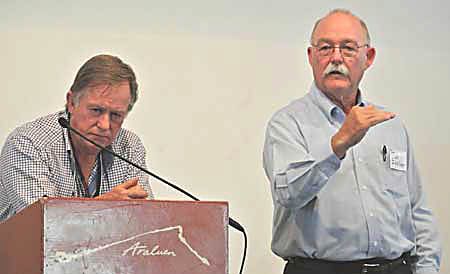 By ERWIN CHLANDA
By ERWIN CHLANDA
The answer from two academics to the question posed by the Strehlow Conference 2014, Where to from here? is not what most people would be happy to hear.
Rolf Gerritsen (at left in the photo) says there is no end in sight to the “covert resistance” displayed by Aborigines towards whitefellers’ efforts – however earnest – to Close The Gap.
And Don Zoellner (at right in the photo) suggests the ballooning spend for a deliberate policy of fixing social problems though the justice system is driving the Northern Territory towards a financial abyss.
Prof Gerritson and Dr Zoellner yesterday kicked off the sharp end of the three day conference in Alice Springs with a chilling double act: one outlining society’s efforts at racial harmony sabotaged by Aborigines disinclined to being bossed around, and the other pencilling the numbers into that picture.
“We worry about our children, their education, are they going to go to uni, take their medicine – we are very different,” said Prof Gerritsen.
“Our” institutions are based on those expectations – a hopeless fit for people not used to large communities. Our institutions are not geared to the needs of small groups surviving in their localities.
Aborigines are pushed by white institutions to adapt to their purposes, “requiring them to become like us,” – and they don’t like it, which is paraphrased as dysfunction.
There is tension between families and distribution coalitions: “The Aboriginal world is one of turmoil and strain,” says Prof Gerritsen.
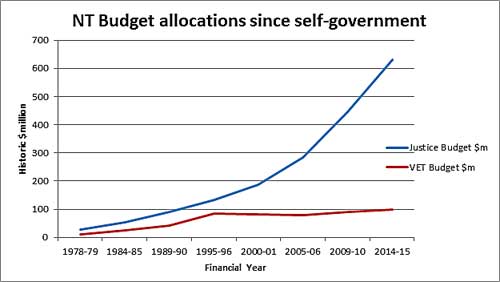 “Have you ever been to a community where people are saying kids shouldn’t go to school?
“Have you ever been to a community where people are saying kids shouldn’t go to school?
“Oh, kids should go to school! But then they actively take them away because they don’t like school, they don’t like the government and they don’t like whitefellers pushing them around.”
He draws parallels with Europe in World War II. His parents were young adults in German-occupied Holland: “What do you do when your country is conquered?”
There were collaborators and resisters – actually most people were a bit of both.
“You collaborate by acquiescing. You resist by putting sugar into the petrol tank of a German truck. Daily life was a whole set of compromises, of your integrity, of your self-esteem, because in many ways you had no choice.”
Arnold Joseph Toynbee wrote about Jewish zealots who couldn’t resist the Roman Empire overtly: “They resisted covertly by retreating into their Jewish beliefs and intensifying their observance of them, emphasising their separateness.”
The others copied the Romans.
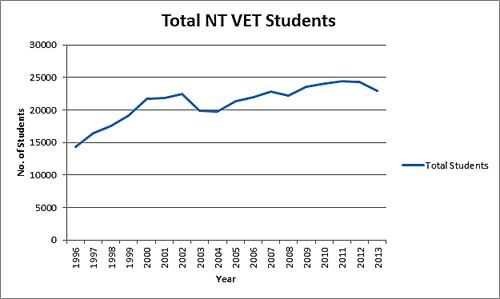 Parallels in the freshly occupied Centre were found in the “Faustian bargain” of Aborigines joining the native police: once the Europeans stopped biffing their people they were quite happy to biff someone else. Better access to women was one reward for young black men.
Parallels in the freshly occupied Centre were found in the “Faustian bargain” of Aborigines joining the native police: once the Europeans stopped biffing their people they were quite happy to biff someone else. Better access to women was one reward for young black men.
Prof Gerritsen says the zealot phase for today’s young men lasts from 14 or 15 until the mid-thirties. Misbehaviour, withdrawal from the system, are the manifestations, driving an unregistered vehicle, having no driver’s licence, accumulating enough fines to go to jail – a form of resistance, “confirming their reaction to what we want them to do. It is covert resistance to what the white society has in mind for them, what the white government is doing to them.”
There are lots of ways for “stuffing the whitefeller around”: in 2012 the Aboriginal vote swung away from Labour, in some places up to 30%, although the CLP didn’t mention the bush very much.
In 2013 the vote swung back the other way, to “Wozza” (Warren Snowdon) who’s represented the electorate “for 20 years too long”.
“We are going to bugger you around because you are not listening to us,” is “their” general message. “It’s putting sugar into our petrol tank.”
The “mechanisms of resistance” are deliberate bad behaviour: “You shouldn’t play cards? They are going to play cards because they know it grinds the whitefellas’ nuts.”
As capitalist Methodists at heart whitefellas are against drinking, and so drinking for Aborigines becomes a “deliberate rejection of the conquerer’s oversight”.
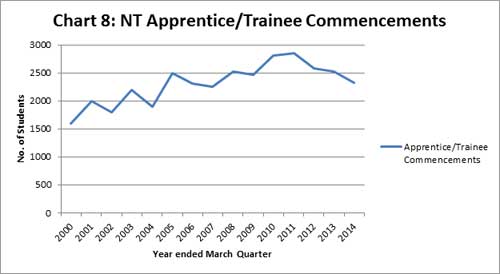 Don’t go to the clinic when you are sick. Terrible statistics for Aboriginal males in their middle age are the consequence.
Don’t go to the clinic when you are sick. Terrible statistics for Aboriginal males in their middle age are the consequence.
On the other hand there is re-establishment of traditional control, such as initiations, attempts by tribal people to regain control, focussing on family, going away on ceremonies, putting their own priorities ahead of the government’s: a form of resistance.
Prof Gerritson says Aborigines “hold in their hand a veto over us, they are buggering us around”.
We want all Aboriginal people to have jobs, and when the statistics look bad, this covert resistance puts pressure on us. Coercive methods such a basics card and imprisonment, play right into their hands.
“The way forward is for us to keep stuffing around for another 10 years, then allow the blackfellas to sort out a way forward,” says Prof Gerritsen.
Dr Zoellner deals in the stark statistics of the – bipartisan yet clearly hapless – Territory policies of lock ’em all up.
The constant baying for skilled labour notwithstanding, successive NT governments have used the justice system as a mechanism to manage the population, at the expense of Vocational Education and Training (VET): Iimprisonment is the “preferred method of dealing with problematic parts of the population, the lower socio-economic portion.”
“Prisonfare replacing welfare, especially social welfare” is practiced here at an extreme level although it is a worldwide phenomenon, but use of prisons as a front-line response is a “re-institutionalisation,” contrary to a global trend of “de-institutionalisation”.
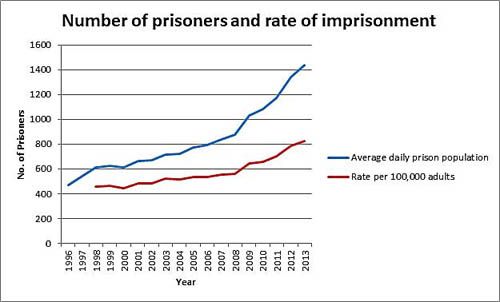 In the NT locking people up has become, more and more, “the first line of defence for a whole host of issues that were formerly [dealt with] by social interventions as opposed to incarceration”.
In the NT locking people up has become, more and more, “the first line of defence for a whole host of issues that were formerly [dealt with] by social interventions as opposed to incarceration”.
Dr Zoellner is looking at the numbers from a convenient zero starting point of 1978, when self-government started in the NT.
Why VET vs the justice system? “They are probably the only two policy levers that are actually controlled by the NT Government” while university places and social welfare are Commonwealth decisions, he says.
He has plotted VET dollars against justice dollars. “Justice” includes the Department of Justice, police, law courts and prisons. It is recurrent expenditure only. Capital expenditure, such as the extensions to the Alice Springs prison and the new jail built for half a billion dollars in the Top End, is not included.
“Socialising” youth and other unemployment, social problems generally, can be achieved in a number of ways, most of them more expensive than the dole, but cosmetically appealing and tacitly consented to by the taxpayer:-
• raising school leaving age;
• age pension;
• uncapping university places, (soaking up 210,000 people in the first decade this century);
• medicalisation (Commonwealth) by skyrocketing numbers of disability support pensioners (one third psychological and psychiatric), with 36% of the entrants coming off the New Start (dole) system;
• imprisonment.
The graphs tell the story.
Dr Zoellner says the public policy of exponential growth in expenditure of the justice system is really concerning: “I don’t know how you find the off button to this trend, not even the slow-down button.”
The prof oversimplifies race relations.
Yes, Aborigines are “pushed by white institutions to adapt to their purposes, requiring them to become like us,” but the Aboriginal reaction is much more complex than just resistance.
Assimilatory endeavours are often subverted when Aboriginal people embrace them but only to take what is valuable in their own lives while rejecting unwanted change.
It’s also a mistake to view Whitefellas as important enough to warrant active resistance.
Aboriginal people play cards to annoy Whitefellas?
They couldn’t be bothered and card playing has important social functions and a way of redistributing wealth.
Initiations, focussing on family, going away on ceremonies are a form of resistance?
These things may happen irrespective of what Whitefella’s think of them but they have long and valued traditions and are not merely expressions of resistance.
It’s not all about “us”.
Did the Dutch really put sugar in the fuel tanks of the Germans?
Sugar, like many items in occupied Holland, was in short supply.
Sand or water or turn on the drain tap and run were much more common actions.
Still, I may be wrong.
Sounds like the whitefellas are talking about the blackfellas again.
It’s a bit like the latest bombing campaign in the Middle East – didn’t work last time, didn’t work the time before that, and it’s dollars to doughnuts it won’t work this time either.
Rolf has produced a very plausible hypothesis, which is supported by a great deal of anthropological, statistical and circumstantial evidence. In doing so, he has given concise expression to a situation which has been fairly obvious for a very long time.
Small bands of highly territorial hunter-gatherers, or collections of extended families based on those bands, had social dynamics, economic practices, and cultural beliefs and priorities that were antithetical to many aspects of colonial village life (let alone population-dense, highly regimented urban life).
These contradictions are amplified for large numbers of their close descendants, who are now surviving in dominant societies that are based on highly atomised life-styles governed by the bureaucratic necessities of the welfare state under conditions such as class stratifications and other inequalities dictated by monopoly capitalism.
The usually self-destructive “covert resistance” is driven by the alienation and anger produced by this colonisation and exploitation, and complicated by the stresses that erupt in multi-clan sedentary conditions.
The resistance is continually reinforced by deep resentment at the colonial state’s counter measures, and compounded by its challenges to traditional patriarchal privileges and their accompanying physical punishment-based problem solving.
The whole shebang is hauled along by the pleasures of cash-fuelled habitual drug consumption and gambling addictions, and subconscious thrills derived from violence and risk.
The alienation is fostered and reproduced by charismatic group leaders amongst the rebellious youth and men in the footy and cannabis sub-cultures, the drinking circles and ceremonial brotherhoods, and leads to the classic “wicked problems” cursed by both sides of this conflict.
However, a “way out” of this impasse is that being taken by many women: simply getting on with raising families and developing their own working lives, i.e. inventing their own futures; and largely leaving much of the baggage of the past, and the general stasis of Aboriginal male existence, for others to worry about.
This is understandable, but it is not an acceptable situation for either responsible Aboriginal male leaders, many Aboriginal women, or the empathetic sections of the dominant society.
Thus we have conferences to reflect on the thoughts of thinkers such as Rolf Gerritsen, Peter Latz, Peter Sutton, Susan Moore, Ken Lechleitner, Bob Beadman, Indra Velasco, Glen Auricht, Philip Batty, Mike Gillam, and the extraordinary, irrepressible, irascible and indefatigable Bill Edwards, and discuss the big question: “Where do we go from here?”
Thank you, John Strehlow and David Moore, for giving us this opportunity to listen to, and debate with, these thinkers.
The challenge now is for Aboriginal leaders and supporters to develop constructive proposals for some new experiments in community development and greater Aboriginal control, in partnership with funding agencies, and involving more Aboriginal men in leadership roles.
There are some organisations providing good examples for this process – the men’s projects being supported by Congress and Tangentyere in Alice Springs and the Jesuit Social Services at Santa Teresa; much of the work of the Walpiri Youth Development (WYDAC) group at Yuendumu; the RFDS Mental Health Services work with Aboriginal men in the Luritye region; the Centrecorp redevelopment of the Memo Club in Alice; the revitalisation of Souths Football Club as a social force for men in Alice; the development of enterprises and the Historic Precinct being supported by the Finke River Mission at Ntaria (Hermannsburg); the proposal for a national Indigenous Cultural Centre being put forward by a consortium of Aboriginal male leaders and organisations in Alice.
These are just a few initiatives which spring to mind. There are also a lot of good initiatives being fostered by CAYLUS, in partnership with a wide range of Aboriginal community groups around the central Australian bush.
If WWIII comes do you think anyone’s going to be bothered if you are Aboriginal or white? Do you think nuclear weapons are selective for black or white?
Yes, the Aboriginals all want the advantage but they only look after the rich and the well. While the Aboriginals are stuffing around they are letting the Muslim radicals get organised and do you think the radical Muslims are going to worry if you are Aboriginal or white? Keep the wider picture in mind.
One thing stands out – it is the pettiness of these radicals that is so damaging. They dont want peace because it advantages them financially.
If the churches want the answer then it comes in the statement that basically says – that people will be having parties, marrying and generally enjoying themselves – then death and sudden destruction.
One example was the twin towers in America – basically no warning. Do you think it can’t happen again either in America, Australia, England, Europe or Asia and Africa?
It really is astounding that people have become so blind to what is actually happening on a world wide basis.
Keep it up and the potential for World War III will become reality and the one thing about war is it affects us all – regardless of race, creed, colour, possessions or position.
@6: Agreed Ralph – if being different is active resistance then sure, but the difference and what underlies it is more complicated and this structures a social universe with drivers and prerogatives that include dealing with whitefellas as well as each other. What is more critical is the question of why we as a society cannot tolerate difference and see fit to return to assimilationism as a means on intervening with difference?
Hit it on the head @ Gareth Lewis.
I think, Gareth Lewis (Posted September 27, 2014 at 8:29 am), that although Gerritsen refers to some instances of active resistance, he is referring mostly to unconscious, subconscious and passive manifestations of resistance and non-cooperation, growing out of a long set of subcultures based on these responses.
As to assimilation, I don’t think Gerritsen was advocating a “return to assimilationism as a means on intervening with difference”.
Just as it is not just about “us” or “resistance”, it’s also not just about “assimilation” or “difference”.
If you are going to privilege “difference” in this debate, it would be useful if you defined exactly which forms of “difference” you think are most relevant here.
I agree with Ralph Folds. For example, Yolngu practices in gurrutu (everyday kinship) and baparru (clan organisation for ceremonies) [loosely translated] are time honoured and resilient. This is Aboriginal governance at work not just a stubborn resistance / reaction to whitefellas. Whitefellas keep changing the rules of engagement, then find the resultant confusion to be Aboriginal resistance.
Yet Gerritsen’s argument, particularly Zoellner’s diagrams are compelling. A chronic failure of governments to provide practical education and meaningful job opportunities undermines the credibility and sustainability of white interventions and the evolution of Aboriginal family / clan governance.
Yes Ralph, it’s not all about us. And is it really useful to talk about ‘Aboriginal people’ like they’re one thing – a conglomerate mass of blacks.
There are all sorts of Aboriginal people doing all kinds of things for all manner of reasons.
If we do have to talk about certain people (to support the point raised by Hal), can we start using more specific terms instead of lumping everyone together?
At the end of the day, we should all be treated as Australians and the rules should be for all, whites, abos and immigrants.
There are too many rules for each culture, and too many do gooders who help no-one.